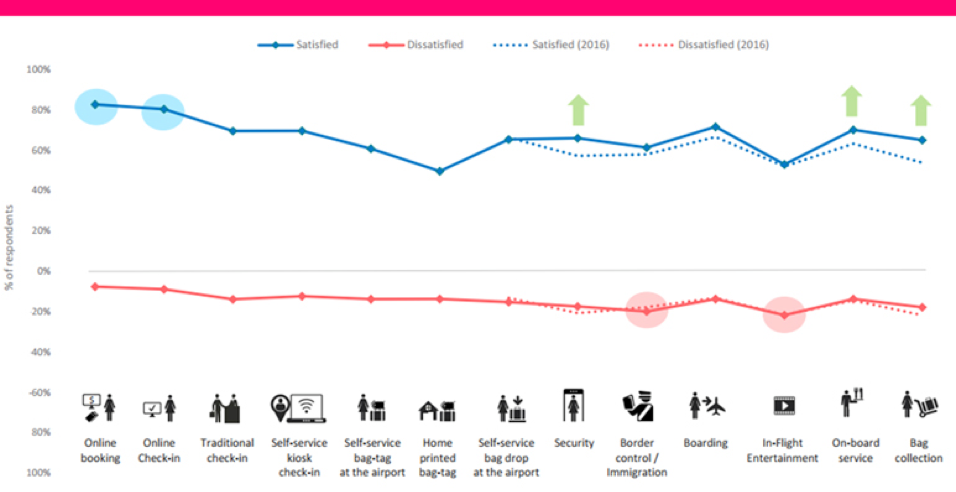IATA's 2017 Global Passenger Survey of 10,675 respondents across 153 countries reveals that passengers expect technology to give them more "personal control over their travel experience."
Among the wish list findings are several critical airport related demands such as greater automation of airport processes like security and border control, which are described as the "biggest pain points".
Especially so is the variation in security screening procedures at different airports, the inconvenience of having to unpack electronic devices in carry-on bags and - worst of all - the intrusiveness of having to remove personal items.
Other desirable developments would include:
- Baggage was the top activity that passengers wanted more control over. 68% of those surveyed want to self-tag their bags, with electronic bag tags being the preferred option. In addition, 48% of passengers wanted to self-drop their bags.
- A single identity token for all travel processes, using biometric identification (the technology of choice, favoured by 64% of respondents);
- Real-time information sent directly to personal devices (63%);
- More efficient security, without having to remove or unpack personal items.
- Boarding the aircraft, with 72% of passengers now preferring to self-board. Passengers want to be able to do more of the airport processes themselves, by taking advantage of the latest digital self-service options.
Similar satisfaction levels throughout the journey; airport self-service, security and boarding satisfaction show a slight increase over 2016
 Source: 2017 Global Passenger Survey Highlights (IATA/Ipsos MORI)
Source: 2017 Global Passenger Survey Highlights (IATA/Ipsos MORI)
Majority of passengers just want to get through the airport as fast as they can
In an article in the CAPA journal, Airline Leader (Issue #40), it was noted that it is not beautiful terminals, advanced technologies manifested in the way of circular runways or floating airports, endless shopping options, gymnasiums, libraries or tropical gardens that dominate most passengers' needs, wants and demands.
Rather, they (still) simply want to get through the airport as quickly as possible at either end of their journey (very, very few are flying for the pleasure of it, and have another purpose altogether). They want to be able to access instant and comprehensive information about their journey at each stage - before leaving the home or office, en route to the airport, at all stages passing through it, and before arrival at the other end.
Current technology
There are new products and systems being introduced around the world on a daily basis to assist passengers. The annual expenditure on airport security systems, for example, which have been increasingly technologically focused since the Pan Am 103 incident in 1988, is set to top USD12.67 billion by 2023. This is even allowing for the fact that the 'silver bullet' - the machine that will dispense with the need to take off your jacket, shoes and belt and to buy your sunscreen airside - is (reportedly) "just around the corner".
The scope for the more mundane and existing technologies is therefore equally as big. The multinational aviation-oriented CIT company SITA, for example, recently said that 51% of airports worldwide plan to implement self-service boarding gate facilities using biometric technology by 2020, and 85% of airports will invest in 'cloud' services over the same period. SITA also believes that 'Internet of Things' initiatives are "becoming investment priorities at airports".
Meanwhile, the all-self-service airport edged a step closer recently with the installation of the world's first biometric bag-drop facility, at Auckland Airport in New Zealand.
The propensity is for a new Internet to emerge that is very specific to this industry; the Internet of Airports if you like.
Ultimately, though, airports cannot afford to lose money on the implementation of any new technology, no matter how much it benefits the customer.
The Blue Swan Daily recently caught up with Foster + Partners' Antoinette Nassopoulos-Erickson to discuss airport builds and technology. Foster + Partners is a global studio for architecture, urbanism and design which has delivered key aviation projects around the world, including airports in Beijing, Hong Kong and Mexico City.
To hear more from Mrs Nassopoulos-Erickson, watch our interview below:
Or watch the keynote discussion at the 2017 CAPA Australia Pacific Aviation and Corporate Travel Summit in Aug-2017: